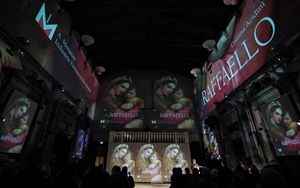(Finance) – He was able to represent harmony while living in a period of tensions and lacerations. It was the emblem of the Late Renaissance and the first to stand as a champion of the protection of antiquity. Raffaello Sanzio and the protagonist of the volume of the Menarini Group art series presentedwith a video-art event, in the deconsecrated church of Santo Stefano al Ponte in Florence, the first Italian center for Experiences of Immersive Art.
Curated by Cristina Acidiniformer superintendent of the art museums of Florence and today president of the Academy of Drawing Arts, the monograph connects life and works highlighting the evolution of the human and artistic aspect of Raphael. And focuses attention on a less well-known biographical aspect, which makes it clear that it is topical, namely its commitment to the protection of ancient monuments, a concept that, in the following centuries, will go a long way and will be at the origin of modern protection. of fine arts.
“At the time – he explains Acidini – what was left of Ancient Rome was being stripped: bronzes were being cast, temples were dismantled to reuse the pieces in an unscrupulous way. Raphael is the first authoritative voice to stand up against the insane scarring of the Roman ruins. He realizes the damage that is being done and, in 1518, writes to Pope Leo X asking to stop the mess. The pope understands this and appoints him “Prefect of antiquity”, a sort of superintendent, the first in history to receive this post “.
A role, that of Raphael, which underlines the need to protect, protect and preserve the traces of the past. Respecting art and promoting his dissemination as much as possible is also one of Menarini’s missions. Indeed, that between the Group and art is a long tradition that continues over time and is renewed.
“With the annual publication of art monographs, for almost seventy years Menarini has had the ability, but above all the perseverance and intelligence, to carry forward multiple messages: to make the Italian masters known, safeguard the national artistic heritage and make them appreciate the singular exceptionality – he explains Giovanni Carlo Federico Villa, Professor of History of Modern Art at the University of Bergamo and director of Palazzo Madama in Turin – These volumes tell an audience of non-experts the great Tuscan, Roman and Venetian art, of the Renaissance and beyond, making them discover, year after year, well-known and lesser-known protagonists. The monographs thus ranged from Beato Angelico, Antonello da Messina, Michelangelo and Caravaggio to Lorenzetti, Benozzo Gozzoli and Pollaiolo. And this – continues Villa – has also allowed art historians to tell them, not through specialized essays or with a language aimed at colleagues, but with an attractive and understandable narration “.
Approaching Italian art is a challenge that Menarini also pursues through the Menarini Pills of Art, video pills designed to make known all over the world the curiosities related to the works of Renaissance artists: almost 600 have been published, divided into 8 languages, with 28 million views. The latest, just published, tells the anecdotes of Raphael’s work “Guido Baldo from Montefeltro“.
“Florence, cradle of the Renaissance and seat of our parent company, has welcomed over the years the greatest artists of all time, including Raphael – they said Lucia and Alberto Giovanni Aleotti, shareholders and members of the Menarini Board – A little more than 500 years after his death, Menarini wanted to celebrate this great artist and all the Renaissance painters protagonists of the historic art series of the Group inaugurated more than half a century ago “.
